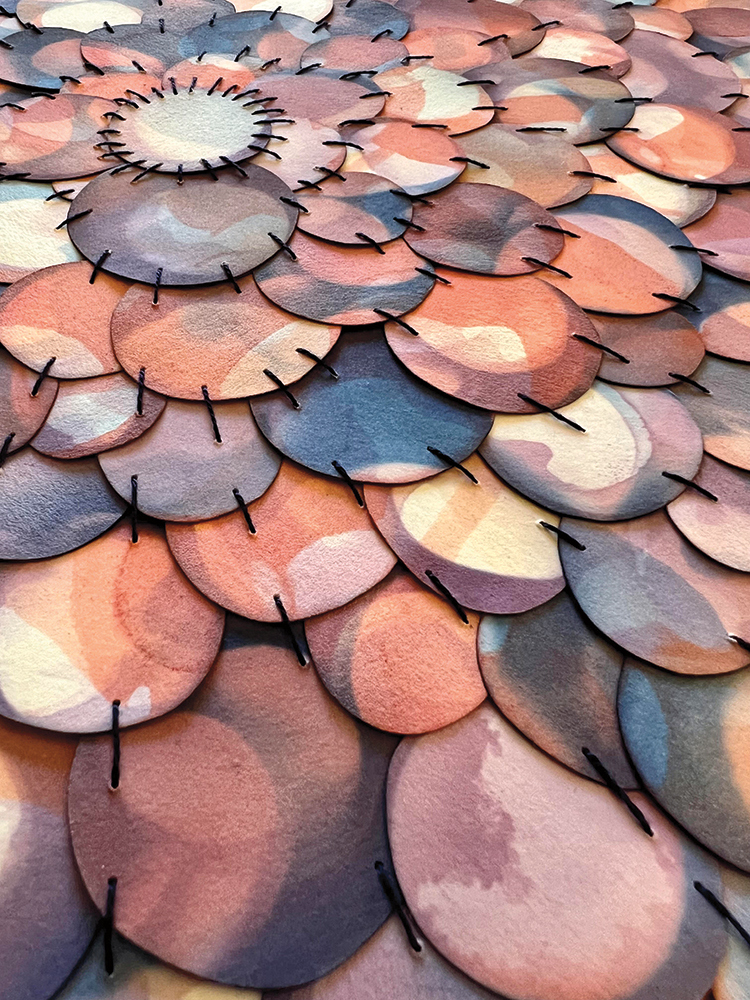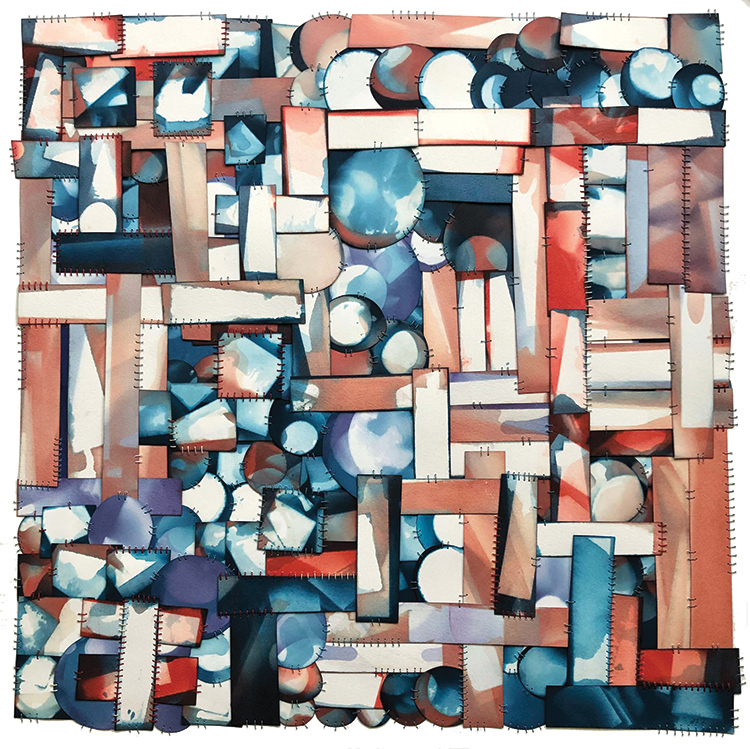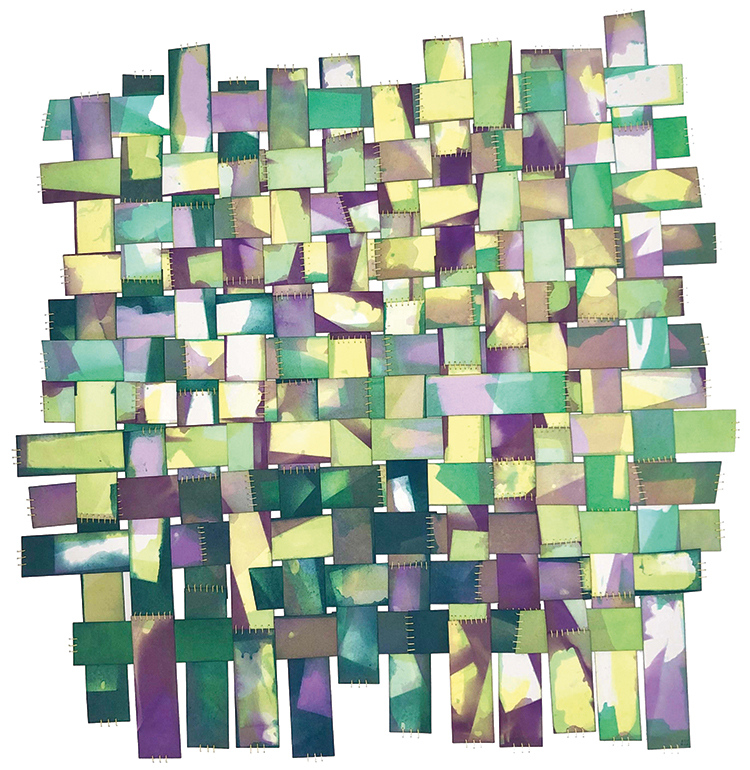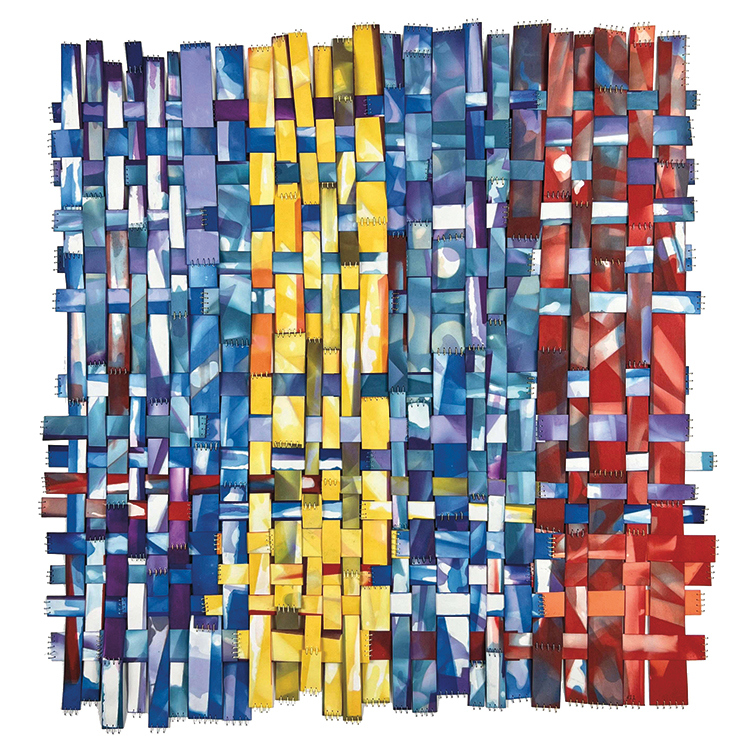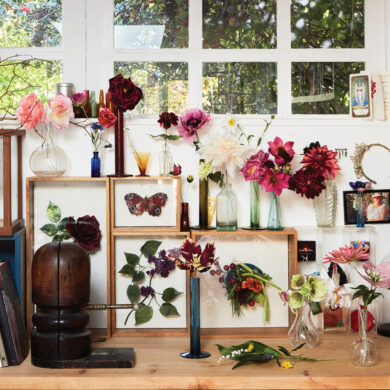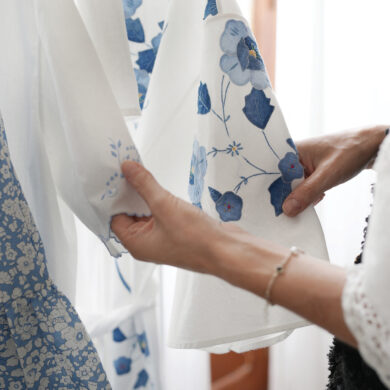Art has always been a significant part of my life at every age. Painting furniture, making mosaics, and studying Wassily Kandinsky paintings are some of my favorite childhood memories. I took art every year through middle and high school.
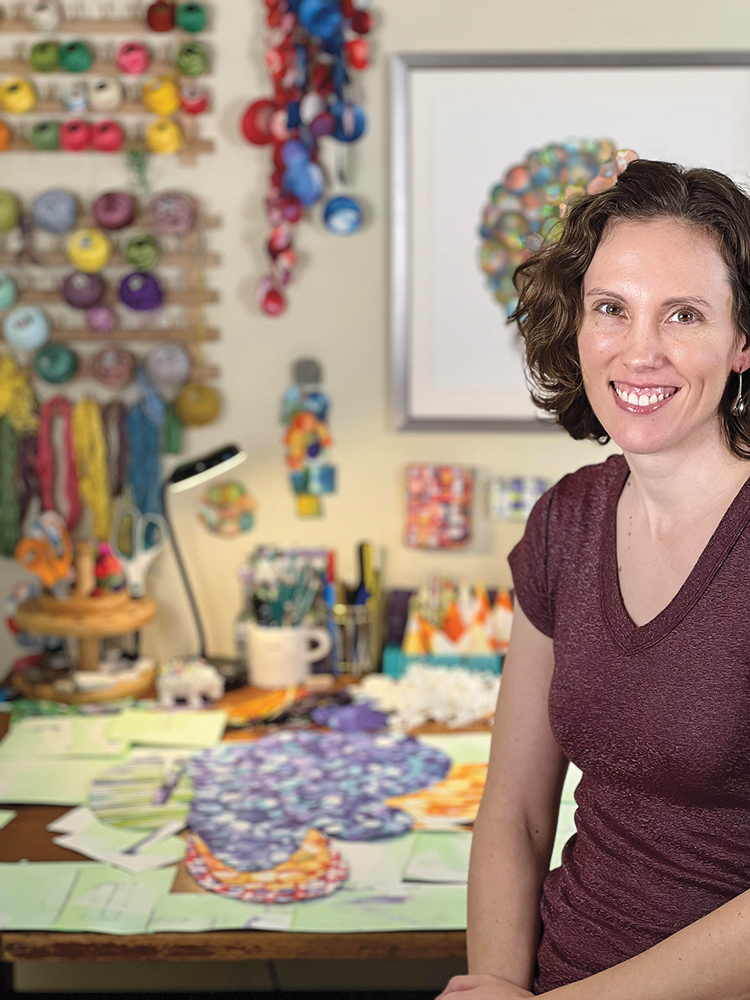
Even so, starting college, I was convinced I didn’t want to major in art. I needed to make a “stable” living as an adult, one with a title such as mathematician (the first idea) or psychologist. The need for an elective in my class schedule put me in an intro art design class. I enjoyed it so much, I thought one more class would be enjoyable.
I took a printmaking class, and the trajectory into art was confirmed. I received an assistantship in college and worked for four master printers and etchers at a national printmaking workshop for two consecutive summers. The few weeks’ apprenticeship each summer was significant in my early training as a printmaker and is where I was initially introduced to the idea of dyeing paper as a part of art making. I graduated with honors with a BFA in printmaking from Sonoma State University in California.
I have been actively dyeing paper and testing different temperatures, water bath strategies, and immersion techniques for about 19 years. I like to spend at least 30 percent of my studio time trying out new ideas with the water dyes and new cutting methods and shapes. I fail often in the studio, but it is a very important part of my process because of what it teaches me. To achieve vivid colors and crisp stitching within each individual piece, I have devoted thousands of hours to testing papers, threads, and combinations of colors. Today, I am happy with where my artwork is after so many years of looking for “what to make.” I was on a searching journey for more than a decade, showing up in the studio but not entirely sure of why or what I was creating. I believed if I continued to show up, one day something would happen to crystalize it for me. I could never have imagined the catalyst.
“Color is a power which directly influences the soul.”
— Wassily Kandinsky
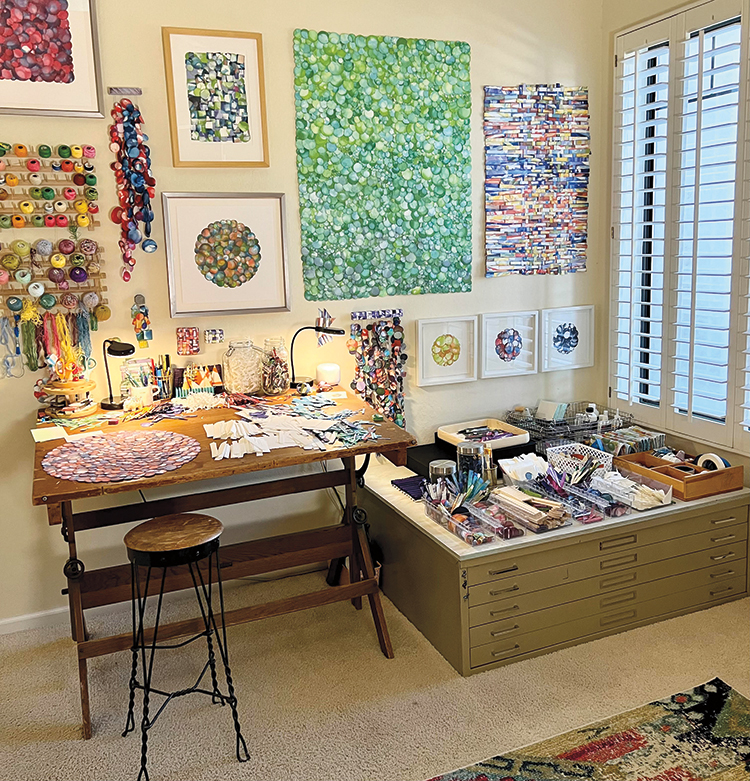
As we slept on October 8, 2017, high winds and fire raged through parts of my city in Northern California. Over the next few days, fires (now collectively called the Sonoma Complex fires) ignited everywhere.
For the first time in our lives, we were evacuated for 11 days. The winds were so erratic no one could predict the direction of the fires each day. We could only wonder if our home would be there when we finally returned, and my way of coping was to say if we lose it, it is okay. We are safe, and that is what matters. And I meant it. And because I meant it, I began to wonder about what I truly valued.
I thought about many things, including my studio and all my work from the last 13 years stored in there. If I could be okay with my work burning, then why am I doing it? Why am I devoting so much time, energy, and years to making it? Am I even an artist after all? Is this a part of an identity that no longer exists?
My home did not burn down. The air was heavy with smoke and ash coated all around outside, but all else was as we left it. However, the experience had me doubting my existence as an artist. Had I held onto the identity of being an artist because it was something I had known my entire life rather than who I really was? Should I keep working?
This caused me to take the most significant creative break I’ve ever taken, which lasted almost four months. My children were very young then, so my studio door was always open but blocked with a baby safety gate. I walked by that studio dozens of times a day.
“You either walk inside your story and own it, or you stand outside your story and hustle for your worthiness.”
— Brené Brown
One day, I spied a dyed and cut paper circle on the studio floor near the door, and something clicked inside. I said to myself, “That’s it. That’s the entire piece.”
For years prior to the work break, I had been trying to incorporate the dyed and cut paper shapes into collages, drawings, prints, and paintings, but they never felt quite right.
From that point on, all of my artwork has focused exclusively on hand cutting, hand dyeing, and hand stitching hundreds upon hundreds of shapes into paper quilts.
Just as the fires forced me to get to the core of what I most value in my life, they also forced me to get to the core of what I most value in my art making. Working with color, texture, shape, and structure is like a meditation for me.
My work now focuses on how the pieces—the moments, the events, the decisions we make—stitch together to create the fabric of our lives. My paper quilts reflect this. Simultaneously to my art journey, I did embark on that “stable career path,” becoming an academic librarian. While the two paths seem incongruous, they do converge in one important aspect.
I have the opportunity to engage with individuals at every stage of life. Because the ways in which we each design our existence fascinates me and motivates my work, the interactions and experiences I have with others weave their way through each of my pieces. The subjects vary but always center around the expression of an emotion, a memory, or a sensation.
Now that I have been through the struggles of finding my artistic voice, I am looking forward to new chapters in my art career of exhibiting, completing more commissions for large public projects, and getting my art out into the world to be enjoyed and create a little calm and peace.
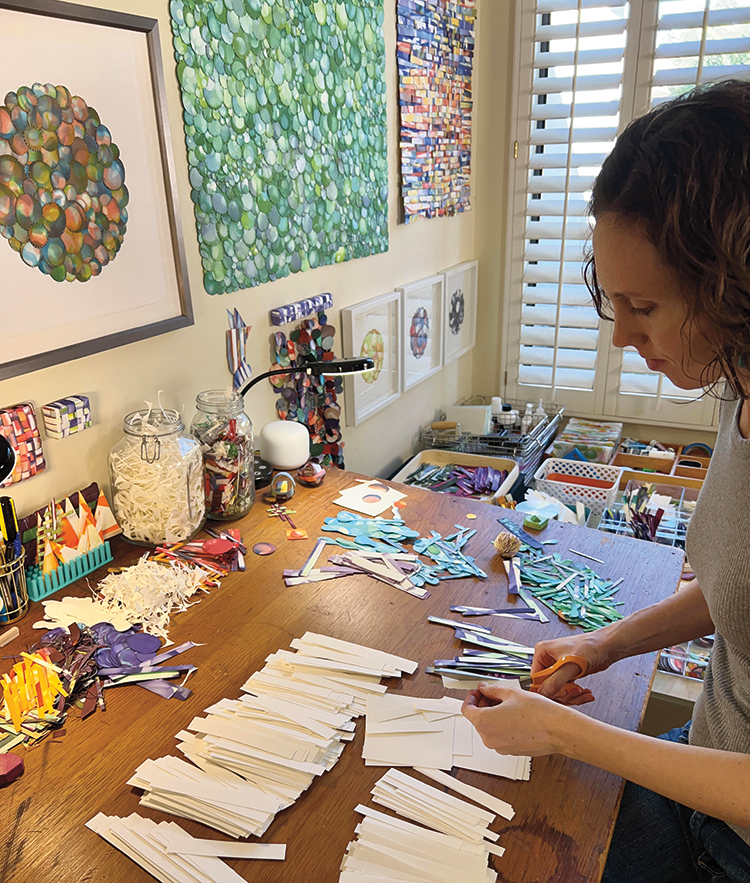
Envisioning the Art
Each piece follows a similar process: sketch out and plan the overall piece, hand cut thousands of shapes, dye each piece with a water dye bath, arrange, and then stitch. It sounds quite simple when outlined like this. However, the process takes weeks or months for each piece. The process is both extremely detailed and very freeing, something I strive for in my life experience. I have a lot of control in the early stages of envisioning and which color dyes I mix, but once the paper is in the dye, I have limited control. I love this part of the process, and it is so freeing. My favorite moment of each piece is the act of pulling each circle or shape out of the water bath and seeing how the color affected each individual shape.
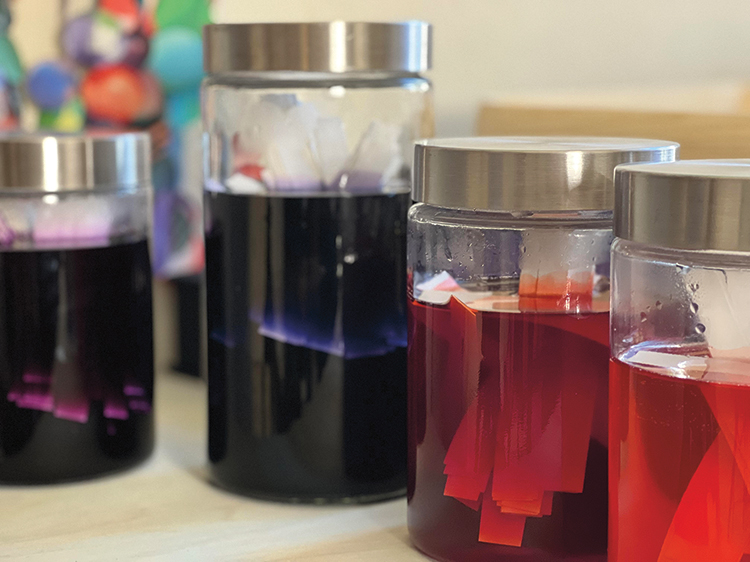
Dyeing the Paper
In the beginning of each piece, I first determine the final size and overall shape of the art. This is important because I do all my dyeing at once, so I need to make sure I have enough small pieces in specific colors before starting. If I am creating a meditation circle where the work results in a peaceful circle of similar colors, then I will cut several hundred circles to start and test in multiple combinations of dye baths. I have used up to 27 color baths in some pieces. I have to carefully consider which colors will overlap with other colors and how best to create rainbow or high-number color palettes.
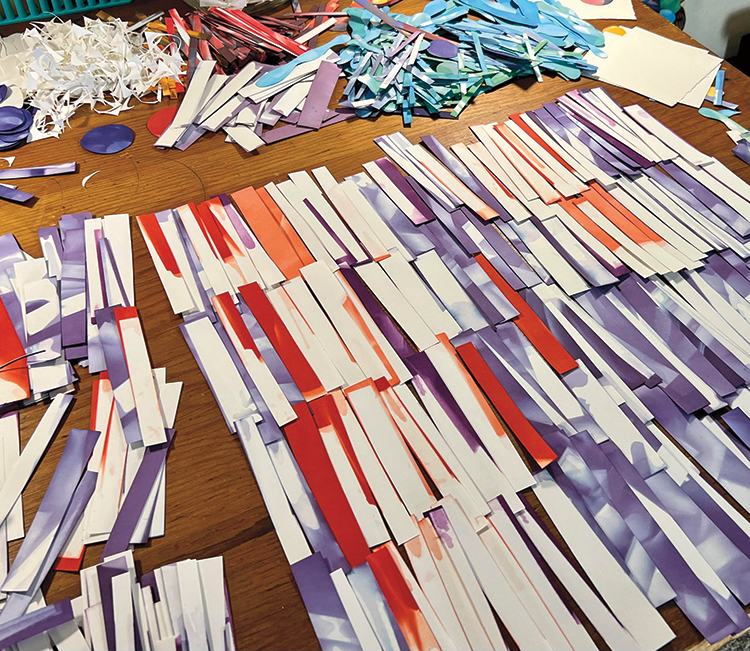
Drying Tape and Reflection
Then, I select a palette of colors through trial tests and mixing colors. I use Rit dye. It has been a steadfast product that is consistent in color and application. I don’t usually write down formulas. I dye each set of white cut shapes in several water baths, which make every color and piece completely unique and made for that individual work. Once the first dye baths are done, drying time takes several days. I patiently wait for the pieces to dry on my vintage fruit fabric.
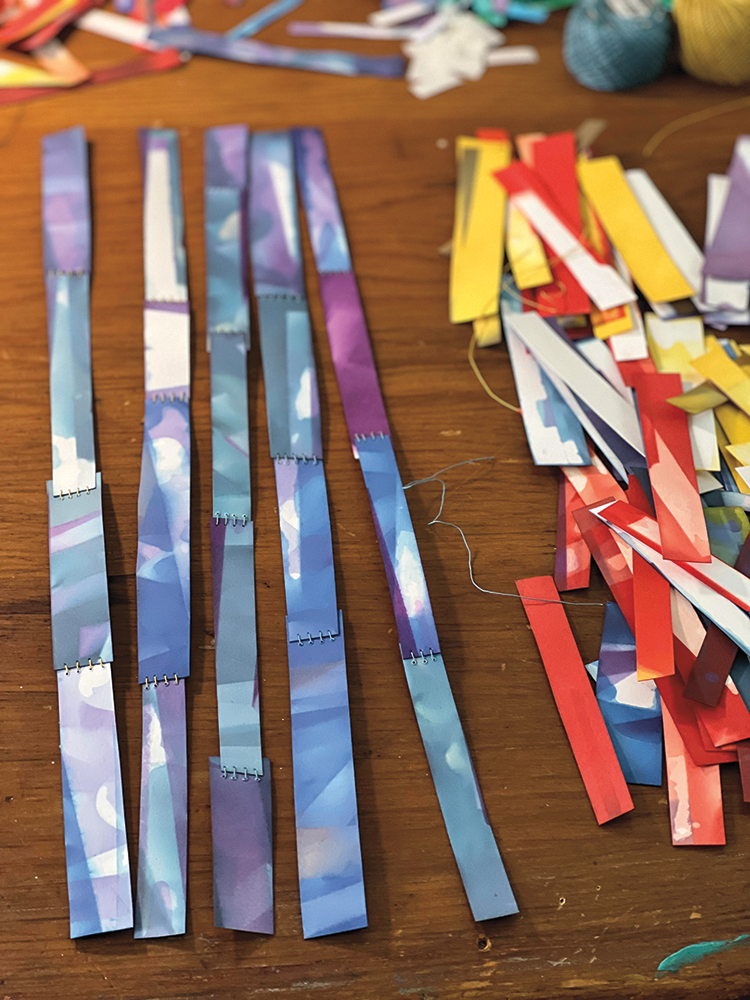
Laying out and Early Stitching
Once each new water bath set is dry, I lay out the pieces in a potential pattern confirming next steps and the direction of the next dye colors I mix up. I also determine at this point if all the pieces will stay in the dye baths for the same amount of time or if there will be incremental pulls of specific sections to give more variety with one color. This intermediate stage of laying out the work is really important because often a shift of the size or color happens here.
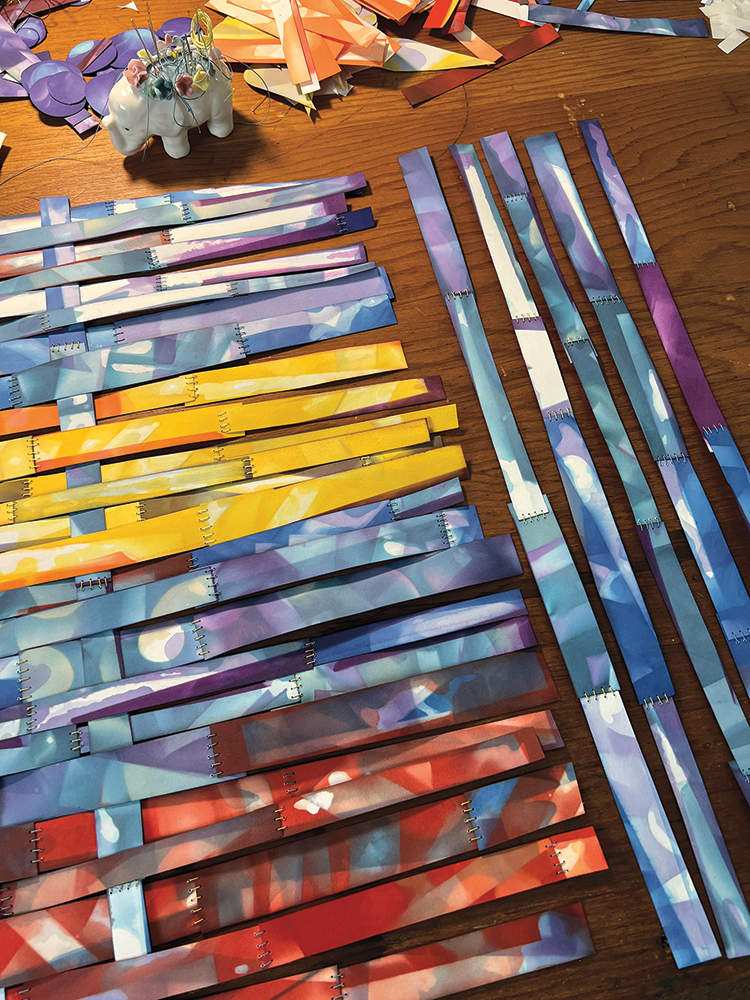
Final Weaving and Stitching
Once all the pieces are dry, I lay out the final piece and begin to tape down the placement with archival tape in order to stitch. For some pieces, I stitch the rows together and then weave. For others, I weave rows together that are only taped down. The size of the piece and if I am trying a new process all determine this next step.
Stitching takes weeks or months for the larger pieces, as sometimes there are thousands of individual stitches holding the paper quilt together.
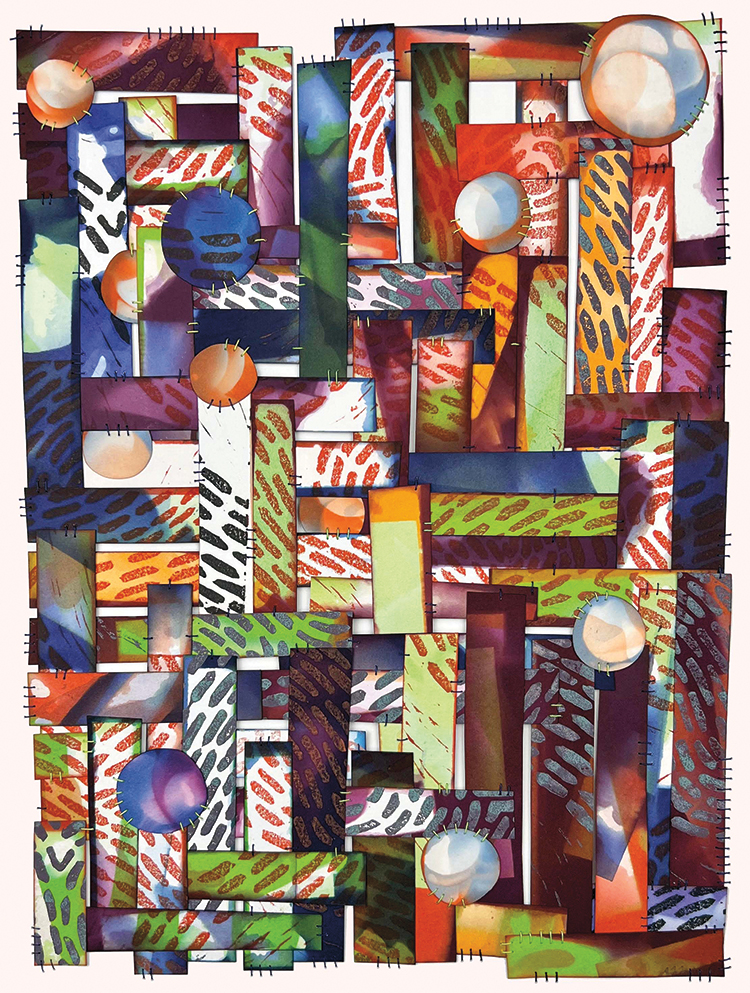
My work is available in person at Practical Art, LLC, In Phoenix, AZ (Instagram: PracticalArtPhx), or online in my shop at www.SamiLangeArt.com (Instagram: SamiLangeArt). More about my creative process and balancing my career and motherhood are also discussed in an interview available at the “Art of Being a Mum” podcast (Season 2).
Art has always been a significant part of my life at every age. Painting furniture, making mosaics, and studying Wassily Kandinsky paintings are some of my favorite childhood memories. I took art every year through middle and high school.

Even so, starting college, I was convinced I didn’t want to major in art. I needed to make a “stable” living as an adult, one with a title such as mathematician (the first idea) or psychologist. The need for an elective in my class schedule put me in an intro art design class. I enjoyed it so much, I thought one more class would be enjoyable.
I took a printmaking class, and the trajectory into art was confirmed. I received an assistantship in college and worked for four master printers and etchers at a national printmaking workshop for two consecutive summers. The few weeks’ apprenticeship each summer was significant in my early training as a printmaker and is where I was initially introduced to the idea of dyeing paper as a part of art making. I graduated with honors with a BFA in printmaking from Sonoma State University in California.
I have been actively dyeing paper and testing different temperatures, water bath strategies, and immersion techniques for about 19 years. I like to spend at least 30 percent of my studio time trying out new ideas with the water dyes and new cutting methods and shapes. I fail often in the studio, but it is a very important part of my process because of what it teaches me. To achieve vivid colors and crisp stitching within each individual piece, I have devoted thousands of hours to testing papers, threads, and combinations of colors. Today, I am happy with where my artwork is after so many years of looking for “what to make.” I was on a searching journey for more than a decade, showing up in the studio but not entirely sure of why or what I was creating. I believed if I continued to show up, one day something would happen to crystalize it for me. I could never have imagined the catalyst.
“Color is a power which directly influences the soul.”
— Wassily Kandinsky

As we slept on October 8, 2017, high winds and fire raged through parts of my city in Northern California. Over the next few days, fires (now collectively called the Sonoma Complex fires) ignited everywhere.
For the first time in our lives, we were evacuated for 11 days. The winds were so erratic no one could predict the direction of the fires each day. We could only wonder if our home would be there when we finally returned, and my way of coping was to say if we lose it, it is okay. We are safe, and that is what matters. And I meant it. And because I meant it, I began to wonder about what I truly valued.
I thought about many things, including my studio and all my work from the last 13 years stored in there. If I could be okay with my work burning, then why am I doing it? Why am I devoting so much time, energy, and years to making it? Am I even an artist after all? Is this a part of an identity that no longer exists?
My home did not burn down. The air was heavy with smoke and ash coated all around outside, but all else was as we left it. However, the experience had me doubting my existence as an artist. Had I held onto the identity of being an artist because it was something I had known my entire life rather than who I really was? Should I keep working?
This caused me to take the most significant creative break I’ve ever taken, which lasted almost four months. My children were very young then, so my studio door was always open but blocked with a baby safety gate. I walked by that studio dozens of times a day.
“You either walk inside your story and own it, or you stand outside your story and hustle for your worthiness.”
— Brené Brown
One day, I spied a dyed and cut paper circle on the studio floor near the door, and something clicked inside. I said to myself, “That’s it. That’s the entire piece.”
For years prior to the work break, I had been trying to incorporate the dyed and cut paper shapes into collages, drawings, prints, and paintings, but they never felt quite right.
From that point on, all of my artwork has focused exclusively on hand cutting, hand dyeing, and hand stitching hundreds upon hundreds of shapes into paper quilts.
Just as the fires forced me to get to the core of what I most value in my life, they also forced me to get to the core of what I most value in my art making. Working with color, texture, shape, and structure is like a meditation for me.
My work now focuses on how the pieces—the moments, the events, the decisions we make—stitch together to create the fabric of our lives. My paper quilts reflect this. Simultaneously to my art journey, I did embark on that “stable career path,” becoming an academic librarian. While the two paths seem incongruous, they do converge in one important aspect.
I have the opportunity to engage with individuals at every stage of life. Because the ways in which we each design our existence fascinates me and motivates my work, the interactions and experiences I have with others weave their way through each of my pieces. The subjects vary but always center around the expression of an emotion, a memory, or a sensation.
Now that I have been through the struggles of finding my artistic voice, I am looking forward to new chapters in my art career of exhibiting, completing more commissions for large public projects, and getting my art out into the world to be enjoyed and create a little calm and peace.

Envisioning the Art
Each piece follows a similar process: sketch out and plan the overall piece, hand cut thousands of shapes, dye each piece with a water dye bath, arrange, and then stitch. It sounds quite simple when outlined like this. However, the process takes weeks or months for each piece. The process is both extremely detailed and very freeing, something I strive for in my life experience. I have a lot of control in the early stages of envisioning and which color dyes I mix, but once the paper is in the dye, I have limited control. I love this part of the process, and it is so freeing. My favorite moment of each piece is the act of pulling each circle or shape out of the water bath and seeing how the color affected each individual shape.

Dyeing the Paper
In the beginning of each piece, I first determine the final size and overall shape of the art. This is important because I do all my dyeing at once, so I need to make sure I have enough small pieces in specific colors before starting. If I am creating a meditation circle where the work results in a peaceful circle of similar colors, then I will cut several hundred circles to start and test in multiple combinations of dye baths. I have used up to 27 color baths in some pieces. I have to carefully consider which colors will overlap with other colors and how best to create rainbow or high-number color palettes.

Drying Tape and Reflection
Then, I select a palette of colors through trial tests and mixing colors. I use Rit dye. It has been a steadfast product that is consistent in color and application. I don’t usually write down formulas. I dye each set of white cut shapes in several water baths, which make every color and piece completely unique and made for that individual work. Once the first dye baths are done, drying time takes several days. I patiently wait for the pieces to dry on my vintage fruit fabric.

Laying out and Early Stitching
Once each new water bath set is dry, I lay out the pieces in a potential pattern confirming next steps and the direction of the next dye colors I mix up. I also determine at this point if all the pieces will stay in the dye baths for the same amount of time or if there will be incremental pulls of specific sections to give more variety with one color. This intermediate stage of laying out the work is really important because often a shift of the size or color happens here.

Final Weaving and Stitching
Once all the pieces are dry, I lay out the final piece and begin to tape down the placement with archival tape in order to stitch. For some pieces, I stitch the rows together and then weave. For others, I weave rows together that are only taped down. The size of the piece and if I am trying a new process all determine this next step.
Stitching takes weeks or months for the larger pieces, as sometimes there are thousands of individual stitches holding the paper quilt together.

My work is available in person at Practical Art, LLC, In Phoenix, AZ (Instagram: PracticalArtPhx), or online in my shop at www.SamiLangeArt.com (Instagram: SamiLangeArt). More about my creative process and balancing my career and motherhood are also discussed in an interview available at the “Art of Being a Mum” podcast (Season 2).







